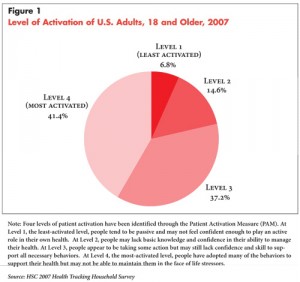The Center for Studying Health System Change has released another information-packed report, How Engaged Are Consumers in Their Health and Health Care, and Why Does It Matter. The researchers created a “Patient Activation Measure” and apparently 41% of adults are what we might call e-patients (empowered, equipped, etc.).
The most activated patients tend to be younger, more educated, and have private health insurance. Hispanics are less likely than non-Hispanics to be activated patients. People living with chronic conditions have lower levels of activation as a group, but there are differences among various conditions: People with depression are likely to be less activated; people with cancer are likely to be more activated.
These lines caught my eye:
It is important to note that it is difficult to discern the direction of causality in the observed relationships as the data were collected at a single moment in time. Longitudinal data are needed to determine whether poor health status causes lower activation, or whether low activation and passivity contribute to poorer health. Likely the causality operates in both directions, although low activation resulting from poor health may lead to a vicious cycle that precludes behaviors that could improve health.
That, to me, is a Holy Grail for e-patient/participatory medicine research. This study is important new evidence, helping me to put into context my own observations about how broadband and health status affect health care information searches, but we really do need longitudinal data.








Susannah,
Thank you for sharing this excellent data.
Another aspect to consider around measuring patient proactivity, and involvement has to do with the role, and or level of caregiver support, if any. It’s a good data point to include in future studies.
It’s secondary for certain, but many friends or family surrounding the chronically-ill, do not know the need for their potential involvement in managing their loved one’s health care experience – until much later in the process, when things go badly, or the patient is overwhelmed in the process.
So, as a part of our Patient Education approaches, should we not flag the potential role of Caregiving? Hence the need to educate Caregiver stakeholders in the e-process, not just patients?
Susan,
when we talk of e-patients we always include caregivers in the definition. For all of us who write in this blog there is no difference between the activated patient and activated caregiver(s). Just look at Chris Gray and you’ll see that empowered patients and caregivers are one and the same as far as understanding what needs to be done to get a better system.
Thanks, Susan! What you write goes to the heart of why “participatory medicine” is becoming the key phrase, rather than “e-patients.” The idea is that everyone — the patient, the home caregivers, the professional caregivers, everyone — can be activated, informed, and engaged.
Susannah,
Yes, I understand this concept is implicit. I didn’t express myself very well I’m afraid. Not all organizations make this inclusion in their audience assumptions.
My comment reflected on whether the Center made that same population assumption (as does e-patients) in drawing conclusions about their chronically-ill participants. Did the Study map the actual role of Caregivers/Advocates in their chronically-ill study population? Not sure, simply because I need to sit down and review the methodolgy, and results more throughly.
If not, we should think about better understanding the underlying behaviors of this group. How should we target chronically-ill patients, and their various subset groups in terms of awareness, and education, tools, materials? Does one overtly cite patients, and caregivers?
This is one of the reasons that large corporations, while investing heavily in Prevention Programs, are also measuring “presenteeism” in their organization year-on-year, and citing Caregiver populations, as a sizeable expense. They acknowledge that Caregiving at 40 million + in 2005, will at least double, if not more by 2010. And with a loss of $2,000/year in productivity, that cost will increase exponentially without the right support.
Just a thought about targeting the the value of e-health to patient/caregiver populations involved the management of chronic illness.